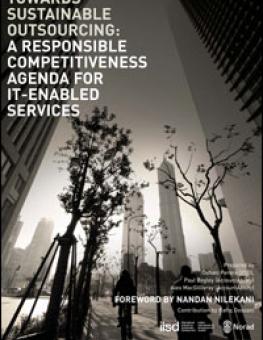
Towards Sustainable Outsourcing: A responsible competitiveness agenda for IT-enabled services
IISD's primer on Responsible Competitiveness in the Information Technology Enabled Services (ITES) explores an ambitious agenda for countries, cities and firms to create an outsourcing model that is genuinely sustainable. In the past decade, sustainable development proponents and the ITES industry have missed two clear opportunities to engage in developing solutions for sustainable development.
They now have a third chance-ITES 3.0, which recognizes that investment in ITES alone, will not automatically increase resource gains and productivity. Rather, ITES needs to be given its due place as a new industry, while investment promotion agencies need to broker agreements that will increase employment, innovation and entrepreneurship in their own countries.
The current global economic downturn will only increase the momentum for ITES 3.0 as governments create even more streamlined value chains, a more equitable distribution of incomes and design stimulus packages to support new 'green' jobs and technologies.
You might also be interested in
Will the Inclusion of Voluntary Standards in Trade Agreements Lead to More Sustainable Trade?
The use of voluntary sustainability standards (VSSs) and similar systems in free trade agreements (FTAs) is gaining traction. Will it lead to more sustainable production and consumption globally?
Strategic Environmental Assessment for the Mining Sector
Strategic environmental assessments (SEA) are an essential tool for policy-makers working to develop a sector-wide vision for responsible mining.
Blackouts and Backsliding: Energy subsidies in South Africa 2023
Blackouts and Backsliding presents the latest energy subsidy data for South Africa.
Sustainable Asset Valuation of Parques del Río Norte in Medellín, Colombia
This economic valuation demonstrates the benefits of expanding urban green space in the city of Medellín, Colombia.